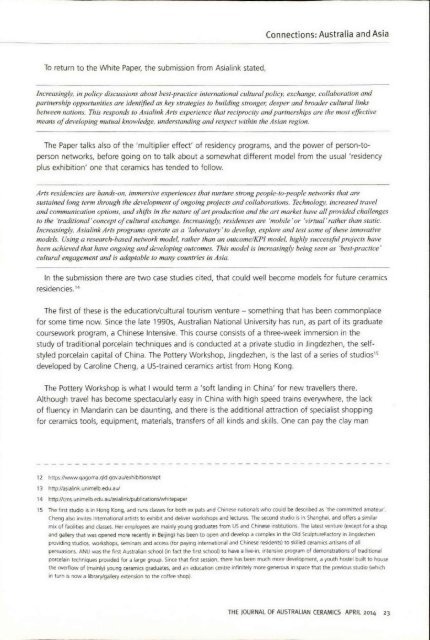The Journal of Australian Ceramics Vol 53 No 1 April 2014
You also want an ePaper? Increase the reach of your titles
YUMPU automatically turns print PDFs into web optimized ePapers that Google loves.
--------- ------------------------------------------------------ ---------------<br />
Connections: Australia and Asia<br />
To return to the White Paper, the submission from Asiali nk stated,<br />
Increasingly, in pulicy discussiom aboUl best-practice in/erna/ional cultural policy, exchange, collaboration wId<br />
partnership opportunities are identified as key strategies to bUilding stronger; deeper and broader cultural links<br />
be/ween 110l;ons. This responds to Asialink Arts experience that reciprocity and partnerships are lire masl effective<br />
means <strong>of</strong> developing mUlual knowledge, understanding and respect within Ihe Asian region.<br />
<strong>The</strong> Paper talks also <strong>of</strong> the 'multiplier effect' <strong>of</strong> residency programs, and the power <strong>of</strong> person-toperson<br />
networks, before going on to talk about a somewhat different model from the usual 'residency<br />
plus exhibit ion ' one that ceramics has tended to follow.<br />
Arts residencies are hands-on, immersive experienct:s that nurture strong people-la-people networks thai are<br />
sustained long term through the development <strong>of</strong> ongoing projects and collaborations. Technology, increased travel<br />
and communication options, and shifts in the nature <strong>of</strong> art production and the art market have all provided challenges<br />
/0 the 'traditional' concepl <strong>of</strong> cultural exchange. Increasing/y, residences are 'mobile' or 'virtual' rather (han stalic.<br />
Increasingly, Asialink Arts programs operale as a 'laboratory' to develop, explore and lest some 0/ these innovaJive<br />
models. U fing a research-based network model, rather Ihan an outcomelKPI model, highly successful projects have<br />
been achieved that have ongoing and developing outcomes. This model is increasingly being seen (IS 'best-practice '<br />
cultural engagement and if adaptable to many countries in Asia.<br />
In the submission there are two case studies cited, that could well become models for future ceramics<br />
residencies. 14<br />
<strong>The</strong> first <strong>of</strong> these is the education/cultural tourism venture - something that has been commonplace<br />
for some time now. Since the late 1990s, <strong>Australian</strong> National University has run, as part <strong>of</strong> its graduate<br />
coursework program, a Chinese Intensive. This course con sists <strong>of</strong> a three-week immersion in the<br />
study <strong>of</strong> traditional porcelain techniques and is conducted at a private studio in Jingdezhen, the selfstyled<br />
porcelain capital <strong>of</strong> China. <strong>The</strong> Pottery Workshop, Jingdezhen, is the last <strong>of</strong> a series <strong>of</strong> studios"<br />
developed by Caroli ne Cheng, a US-trained ceramics artist from Hong Kong.<br />
<strong>The</strong> Pottery Workshop is what I would term a 's<strong>of</strong>t landing in China' for new travellers there.<br />
Although travel has become spectacularly easy in China w ith high speed trains everywhere, the lack<br />
<strong>of</strong> fluency in Mandarin can be daunting, and there is the additional attraction <strong>of</strong> specialist shopping<br />
for ceramics tools, equ ipment, materials, transfers <strong>of</strong> all kinds and skills. One can pay the clay man<br />
12 htlps:llwww qagoma.qld .gov.aulexhlbitionslapt<br />
13 http://asial!nk.unlmelb.edu.aul<br />
14 hnp1lcms.unimelb.edu.aulasialinklpublkatlooslwhitepaper<br />
15 <strong>The</strong> first studIO is in Hong Kong, and runs classes for both ex pats and Chinese nationals who could be descnbed as 'the commined amateur'.<br />
Cheng also invites international artists to exhibit and deliver workshops and lectures. <strong>The</strong> second studio i5 in Shanghai, and <strong>of</strong>fers oil Similar<br />
mix <strong>of</strong> faCIlities and classes. Her employees are mainly young graduates from US and Chinese institutions. <strong>The</strong> latest venlure (except for a shop<br />
and gallery that was opened more recently In Beijing) has been to open and develop a complex in the Old $culpturefactory in Jmgdezhen<br />
providing studios, wortshops, seminars and access (for paying international and Chinese residents) to skilled ceramics artisans <strong>of</strong> all<br />
persuaSIOns. ANU was the first <strong>Australian</strong> school (in fact the first school) to have a live-m, intensive program <strong>of</strong> demonstratIOns <strong>of</strong> traditional<br />
porcelain techniques provided for a large group. Since that first session, there has been much more development, a youth hostel built to hou~<br />
the overflow <strong>of</strong> (mainly) young ceramics graduates, and an education centre mfinitely more generous In space that the previous studio (which<br />
in turn is now a library/gallery extension 10 the c<strong>of</strong>fee shop).<br />
THE JOURNAL Of AUSTRALIAN CERAMICS APRIL <strong>2014</strong> 23

















